JAJSGO9C July 2013 – May 2017 TAS5760L
PRODUCTION DATA.
- 1 特長
- 2 アプリケーション
- 3 概要
- 4 改訂履歴
- 5 Pin Configuration and Functions
-
6 Specifications
- 6.1 Absolute Maximum Ratings
- 6.2 ESD Ratings
- 6.3 Recommended Operating Conditions
- 6.4 Thermal Information
- 6.5 Digital I/O Pins
- 6.6 Master Clock
- 6.7 Serial Audio Port
- 6.8 Protection Circuitry
- 6.9 Speaker Amplifier in All Modes
- 6.10 Speaker Amplifier in Stereo Bridge-Tied Load (BTL) Mode
- 6.11 Speaker Amplifier in Mono Parallel Bridge-Tied Load (PBTL) Mode
- 6.12 I²C Control Port
- 6.13 Typical Idle, Mute, Shutdown, Operational Power Consumption
- 6.14 Typical Speaker Amplifier Performance Characteristics (Stereo BTL Mode)
- 6.15 Typical Performance Characteristics (Mono PBTL Mode)
- 7 Parameter Measurement Information
-
8 Detailed Description
- 8.1 Overview
- 8.2 Functional Block Diagram
- 8.3 Feature Description
- 8.4
Device Functional Modes
- 8.4.1
Hardware Control Mode
- 8.4.1.1 Speaker Amplifier Shut Down (SPK_SD Pin)
- 8.4.1.2 Serial Audio Port in Hardware Control Mode
- 8.4.1.3 Soft Clipper Control (SFT_CLIP Pin)
- 8.4.1.4 Speaker Amplifier Switching Frequency Select (FREQ/SDA Pin)
- 8.4.1.5 Parallel Bridge Tied Load Mode Select (PBTL/SCL Pin)
- 8.4.1.6 Speaker Amplifier Sleep Enable (SPK_SLEEP/ADR Pin)
- 8.4.1.7 Speaker Amplifier Gain Select (SPK_GAIN [1:0] Pins)
- 8.4.1.8 Considerations for Setting the Speaker Amplifier Gain Structure
- 8.4.2 Software Control Mode
- 8.4.1
Hardware Control Mode
- 8.5
Register Maps
- 8.5.1 Control Port Registers - Quick Reference
- 8.5.2
Control Port Registers - Detailed Description
- 8.5.2.1 Device Identification Register (0x00)
- 8.5.2.2 Power Control Register (0x01)
- 8.5.2.3 Digital Control Register (0x02)
- 8.5.2.4 Volume Control Configuration Register (0x03)
- 8.5.2.5 Left Channel Volume Control Register (0x04)
- 8.5.2.6 Right Channel Volume Control Register (0x05)
- 8.5.2.7 Analog Control Register (0x06)
- 8.5.2.8 Reserved Register (0x07)
- 8.5.2.9 Fault Configuration and Error Status Register (0x08)
- 8.5.2.10 Reserved Controls (9 / 0x09) - (15 / 0x0F)
- 8.5.2.11 Digital Clipper Control 2 Register (0x10)
- 8.5.2.12 Digital Clipper Control 1 Register (0x11)
-
9 Application and Implementation
- 9.1 Application Information
- 9.2
Typical Applications
- 9.2.1 Stereo BTL Using Software Control
- 9.2.2 Stereo BTL Using Hardware Control
- 9.2.3 Mono PBTL Using Software Control
- 9.2.4 Mono PBTL Using Hardware Control
- 9.2.5 Stereo BTL Using Software Control, 32-Pin DAP Package Option
- 9.2.6 Stereo BTL Using Hardware Control, 32-Pin DAP Package Option
- 9.2.7 Mono PBTL Using Software Control, 32-Pin DAP Package Option
- 9.2.8 Mono PBTL Using Hardware Control, 32-Pin DAP Package Option
- 10Power Supply Recommendations
- 11Layout
- 12デバイスおよびドキュメントのサポート
- 13メカニカル、パッケージ、および注文情報
パッケージ・オプション
メカニカル・データ(パッケージ|ピン)
サーマルパッド・メカニカル・データ
発注情報
6.15 Typical Performance Characteristics (Mono PBTL Mode)
At TA = 25°C, fSPK_AMP = 384 kHz, input signal is 1 kHz Sine unless otherwise noted.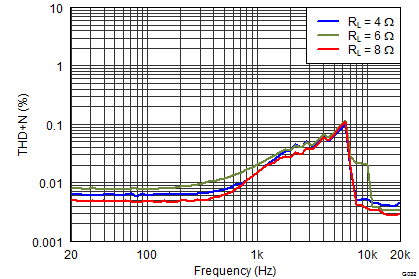
PVDD = 12 V, POSPK = 1 W
Figure 26. THD+N vs Frequency 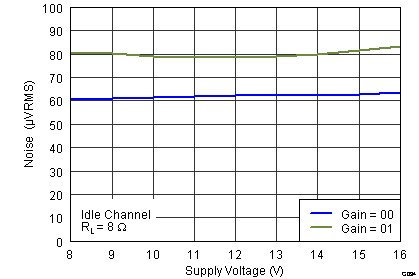 Figure 28. Idle Channel Noise vs PVDD
Figure 28. Idle Channel Noise vs PVDD 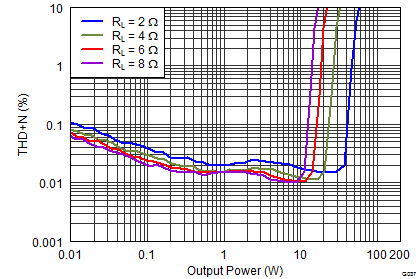
PVDD = 12 V with 1 kHz Sine Input
Figure 30. THD+N vs Output Power 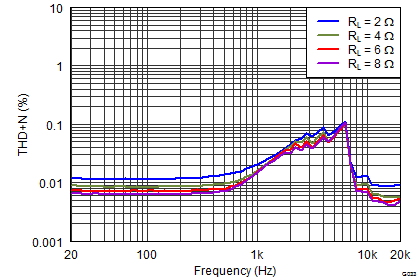
PVDD = 12 V, POSPK = 1 W
Figure 27. THD+N vs Frequency 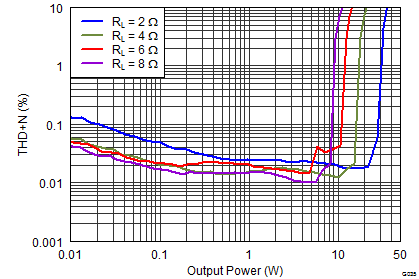
PVDD = 12 V with 1 kHz Sine Input
Figure 29. THD+N vs Output Power 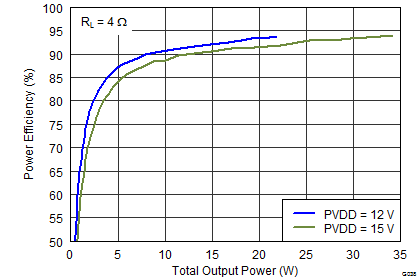 Figure 31. Efficiency vs Output Power
Figure 31. Efficiency vs Output Power 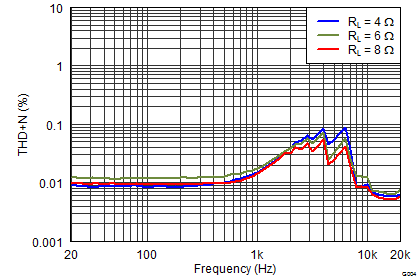
PVDD = 12 V, POSPK = 1 W
Figure 32. THD+N vs Frequency 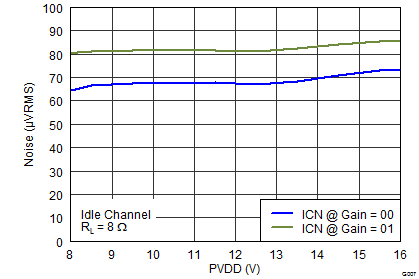 Figure 34. Idle Channel Noise vs PVDD
Figure 34. Idle Channel Noise vs PVDD 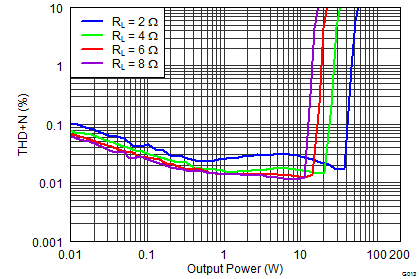 Figure 36. THD+N vs Output Power with PVDD = 12 V
Figure 36. THD+N vs Output Power with PVDD = 12 V 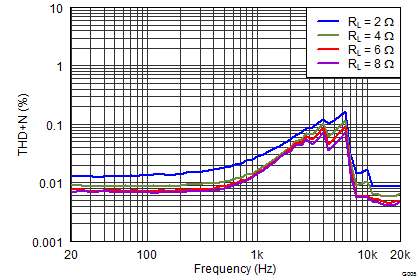
PVDD = 12 V, POSPK = 1 W
Figure 33. THD+N vs Frequency 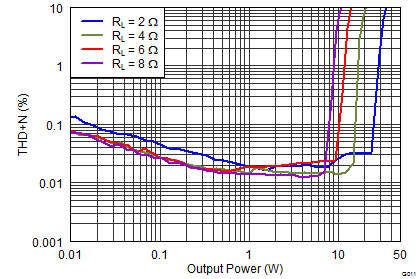 Figure 35. THD+N vs Output Power with PVDD = 12 V
Figure 35. THD+N vs Output Power with PVDD = 12 V 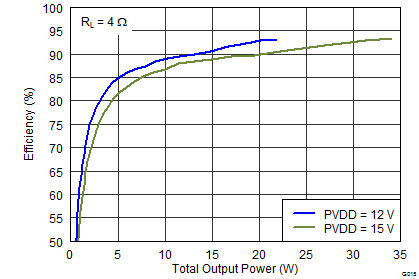 Figure 37. Efficiency vs Output Power
Figure 37. Efficiency vs Output Power